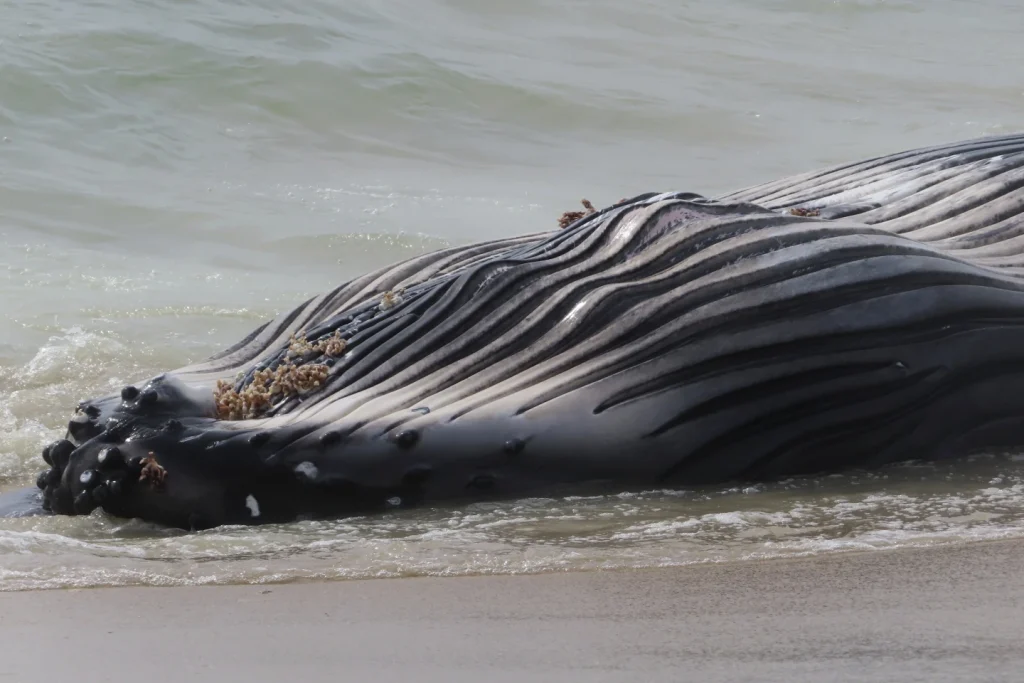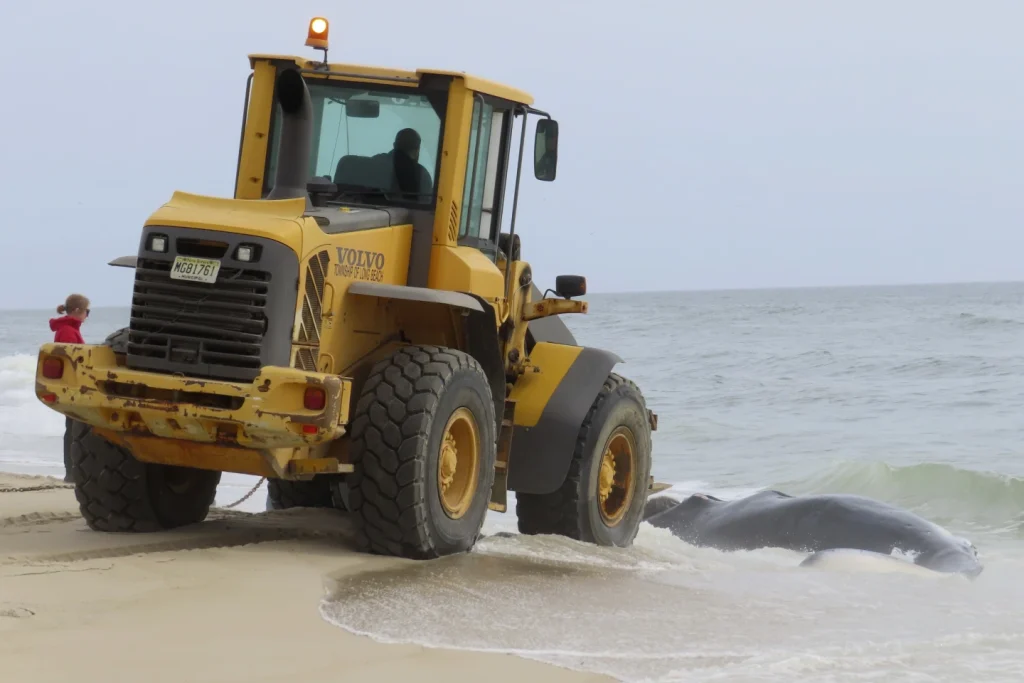The tragic discovery of a deceased humpback whale on Long Beach Island in New Jersey has sparked concern and raised questions about the well-being of marine life in the region.
The recent post-mortem examination conducted by the Marine Mammal Stranding Center unveiled distressing findings, indicating that the juvenile male humpback whale had suffered severe blunt force injuries, including a fractured skull and vertebrae.
Sheila Dean, the director of the center, shared the distressing details of the necropsy in a statement, revealing the extent of the injuries sustained by the whale.
The examination revealed bruising around the head, multiple fractures of the skull and cervical vertebrae, dislocated ribs, and a dislocated shoulder bone. These injuries, as Dean pointed out, are indicative of blunt force trauma, suggesting a violent encounter that led to the whale’s untimely demise.
While the exact cause of these injuries remains unknown, Dean emphasized the need for further investigation and testing to determine the circumstances surrounding the whale’s death.
Tissue samples have been sent to laboratories across the country for analysis, underscoring the importance of a thorough and comprehensive examination to shed light on this tragic incident.
The discovery of the deceased humpback whale has reignited concerns about the impact of human activities on marine life, particularly in the context of offshore wind power projects. Opponents of offshore wind power have raised alarms about the potential harm to whales during site preparation work for these projects.
However, scientific authorities, including the National Oceanic and Atmospheric Administration, the Marine Mammal Commission, the U.S.
Bureau of Ocean Energy Management, and the New Jersey Department of Environmental Protection, have refuted these claims, stating that there is no evidence linking offshore wind preparation to whale deaths.
The broader context of whale mortality on the East Coast further underscores the urgency of understanding and addressing threats to these majestic creatures.
According to NOAA, there have been 16 large whale deaths reported on the East Coast in 2024, encompassing a range of species including humpbacks, North Atlantic right whales, sperm whales, minke whales, and a fin whale.
The loss of these magnificent animals highlights the pressing need for conservation efforts and measures to protect marine ecosystems.
In conclusion, the tragic death of the humpback whale on Long Beach Island serves as a poignant reminder of the fragility of marine life and the importance of conservation efforts.
As we await further insights from the ongoing investigation, it is imperative that we strive to safeguard our oceans and the diverse species that inhabit them.
Only through collective action and a commitment to environmental stewardship can we ensure a sustainable future for our planet’s precious marine life.
In 2023, a concerning trend emerged along the East Coast with the report of 82 large whale deaths, as disclosed by the relevant agency.
This revelation brought to light the fragile state of marine life in the region and raised alarm bells regarding the potential threats faced by these majestic creatures.
Among the affected regions, New Jersey recorded its first whale fatality of the year, following a total of 14 such incidents in 2023 alone.
The backdrop against which these tragic events unfolded is characterized by the ongoing discussions surrounding the establishment of wind farms off the New Jersey coast, notably the Leading Light Wind project among the proposed ventures.
In response to the escalating concerns, the project issued a statement emphasizing the importance of guarding against misinformation campaigns in the wake of these incidents.
It pointed out that previous whale deaths have often been linked to vessel strikes or entanglement with fishing gear, as highlighted by scientific research.
Amidst these developments, various stakeholders have voiced diverging opinions and concerns regarding the handling of the situation.
Notably, Protect Our Coast NJ, a prominent anti-offshore wind group, expressed skepticism towards the official explanations provided for the whale deaths.
Drawing parallels to the skepticism surrounding official narratives during the COVID-19 pandemic, the group questioned the attribution of all cetacean fatalities to entanglements and ship strikes.
In a statement released on Thursday, the group underscored the need for a critical examination of the circumstances surrounding the whale deaths, cautioning against simplistic explanations that may overlook underlying complexities.

The analogy drawn by Protect Our Coast NJ between the handling of cetacean deaths and the classification of COVID-19 fatalities serves to underscore the importance of transparency and thorough investigation in understanding complex phenomena.
By highlighting the potential pitfalls of oversimplification and the dangers of dismissing alternative perspectives, the group seeks to encourage a more nuanced approach towards addressing the challenges faced by marine ecosystems.
In conclusion, the spate of large whale deaths along the East Coast in 2023 serves as a stark reminder of the interconnectedness of human activities and the natural world.
As debates surrounding offshore wind farms and marine conservation continue to unfold, it is imperative that all stakeholders engage in constructive dialogue, grounded in scientific evidence and a commitment to preserving biodiversity.
Only through collaborative efforts and a shared sense of responsibility can we hope to safeguard the delicate balance of our oceans and protect the magnificent creatures that inhabit them.
In the realm of renewable energy, offshore wind farms stand as beacons of hope, promising to harness the power of the wind to propel us towards a greener, more sustainable future.
However, as with any human endeavor, the pursuit of progress must be tempered by a deep sense of responsibility towards the environment and its inhabitants.
The recent announcement by Leading Light, regarding their offshore wind project off Long Beach Island, serves as a poignant reminder of the delicate equilibrium that must be maintained between technological advancement and ecological preservation.
At the heart of Leading Light’s vision lies a steadfast commitment to minimizing risks to wildlife, particularly the denizens of the marine realm.
The assertion by the project’s leaders that “Minimizing impacts to the marine environment is of the utmost importance to Leading Light Wind” underscores a recognition of the intrinsic value of biodiversity and the need to safeguard it for future generations.
This proactive stance, which includes providing advance notices of survey activities and engaging with maritime stakeholders, exemplifies a commendable dedication to transparency and collaboration in the pursuit of sustainable development.
Central to the discourse surrounding offshore wind projects is the imperative of mitigating potential risks to marine life, particularly vulnerable species such as whales.
The tragic incident involving the stranded whale, with evidence of past entanglement with fishing gear, serves as a poignant reminder of the perils faced by marine creatures in an increasingly anthropogenically altered environment.
The scars of previous entanglements, though unrelated to the recent stranding event, serve as poignant testaments to the enduring impact of human activities on marine ecosystems.
In light of these sobering realities, the emphasis on monitoring and mitigation initiatives by Leading Light Wind emerges as a beacon of hope amidst a sea of challenges.
By investing in technologies and strategies aimed at minimizing adverse impacts on marine life, the project sets a precedent for responsible stewardship in the burgeoning offshore wind industry.
Through a combination of technological innovation, stakeholder engagement, and ecological vigilance, Leading Light Wind seeks to pave the way for a harmonious coexistence between renewable energy development and marine conservation.
As we stand at the cusp of a pivotal juncture in human history, characterized by the urgent need to transition towards sustainable energy sources, the case of Leading Light Wind serves as a microcosm of the broader tensions between progress and preservation.

The success of offshore wind projects hinges not only on their capacity to generate clean energy but also on their ability to coexist harmoniously with the natural world.
In this delicate dance between human ambition and environmental stewardship, the choices we make today will reverberate across generations, shaping the legacy we leave for posterity.
In conclusion, the narrative of Leading Light Wind’s offshore wind project off Long Beach Island encapsulates the complexities inherent in the pursuit of sustainable development.
By prioritizing environmental protection, fostering collaboration, and embracing a culture of responsibility, the project exemplifies a paradigm shift towards a more holistic and inclusive approach to energy production.
As we navigate the uncharted waters of the renewable energy landscape, let us heed the lessons of Leading Light Wind and strive towards a future where progress and preservation walk hand in hand, guided by the beacon of sustainability and the imperative of coexistence.
